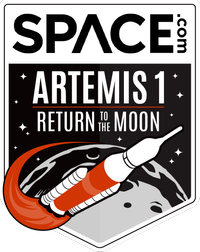Artemis 1 moon rocket 'ready to go' for Nov. 14 launch, NASA says
"If we weren't confident, we wouldn't roll out."


While NASA officials stressed in a media teleconference today (Nov. 3) that the agency's highly anticipated Artemis 1 moon mission will be challenging, they stated they are confident in the upcoming launch attempt on Nov. 14.
The Artemis 1 mission stack, consisting of the massive Space Launch System (SLS) rocket and Orion spacecraft, is scheduled to once again roll out to Launch Pad 39B from NASA's Vehicle Assembly Building (VAB) at Kennedy Space Center (KSC) in Florida at 12:01 a.m. EDT (0401 GMT) on Friday (Nov. 4). The SLS stack has been to the pad on three previous occasions, once each in March and June for pre-launch fueling tests, and again in mid-August for two abortive launch attempts. The rocket was then rolled back into the VAB on Sept. 27 to ride out Hurricane Ian, where it has been ever since undergoing repairs and pre-flight checks.
Despite these setbacks, NASA officials stressed in today's media briefing that they stand behind the new mission timeline, which aims for a launch attempt at 12:07 a.m. EST (0507 GMT) on Nov. 14. "If we weren't confident, we wouldn't roll out. If we weren't confident, we wouldn't start the countdown when we do so. We're confident moving forward," said Jim Free, associate administrator of the Exploration Systems Development Mission Directorate at NASA headquarters in Washington, D.C.
Related: Watch NASA roll Artemis 1 moon rocket to launch pad early Friday
Free added that the Artemis 1 mission has been a challenge from the start. "I do want to reflect on the fact that this is a challenging mission," Free told reporters. "We've seen challenges just getting all our systems to work together. And that's why we do a flight test. It's about going after the things that can't be modeled. And we're learning by taking more risks on this mission before we put crew on there. And those challenges, you know, come with this complex of a vehicle and where we're flying and how we're getting there."
"The good part in all this is our team continues to grow and learn about the vehicle," he added.
While SLS has been in the VAB for the past five weeks, NASA engineers have been replacing SLS flight termination system hardware, recharging Orion's batteries, and replacing payload batteries, including the ones in some of the mission's 10 ridealong cubesats.
Breaking space news, the latest updates on rocket launches, skywatching events and more!
"Since rolling back to the VAB for Hurricane Ian, the team has been hard at work," said Cliff Lanham, senior vehicle operations manager of the Exploration Ground Systems Program at KSC. "The work in the VAB has gone smoothly, and we've been able to protect the rocket from the hurricane, and we've been able to get into our inspections and make repairs. "
Lanham added that, with preflight work now nearing completion, NASA's teams at KSC have begun preparing for Friday's rollout to Launch Pad 39. "We started retracting our platforms. We're actually retracting our final platform now. And the crawler transporter is now in the high bay underneath the mobile launcher."
Space.com asked NASA officials whether or not the previous scrubbed launch attempts and the widespread media scrutiny that followed has affected the morale of the many personnel working on the Artemis 1 mission.
"These are a professional group of people whose first allegiance is to the hardware and doing things right. And when we give you all the discussions like this, I appreciate the questions and the ability to kind of address things like you just said, the criticisms that are thrown our way," Free told Space.com. "We're spending taxpayer dollars. We should be open to criticism and answering questions, but it will never put us in the place of pushing too hard to launch too fast or making a bad decision."
Lanham added that the team's enthusiasm has never waned despite the mission's previous setbacks. "We are back in terms of ready to go and excited down here."
Artemis 1 will send an uncrewed Orion on a long journey to lunar orbit and back. It's the first mission in NASA's Artemis program of moon exploration, which aims to put people down near the lunar south pole in 2025 or 2026 and establish a sustainable human presence on and around the moon by the end of the decade.
Follow Brett on Twitter at @bretttingley. Follow us on Twitter @Spacedotcom or on Facebook.

Brett is curious about emerging aerospace technologies, alternative launch concepts, military space developments and uncrewed aircraft systems. Brett's work has appeared on Scientific American, The War Zone, Popular Science, the History Channel, Science Discovery and more. Brett has degrees from Clemson University and the University of North Carolina at Charlotte. In his free time, Brett enjoys skywatching throughout the dark skies of the Appalachian mountains.

